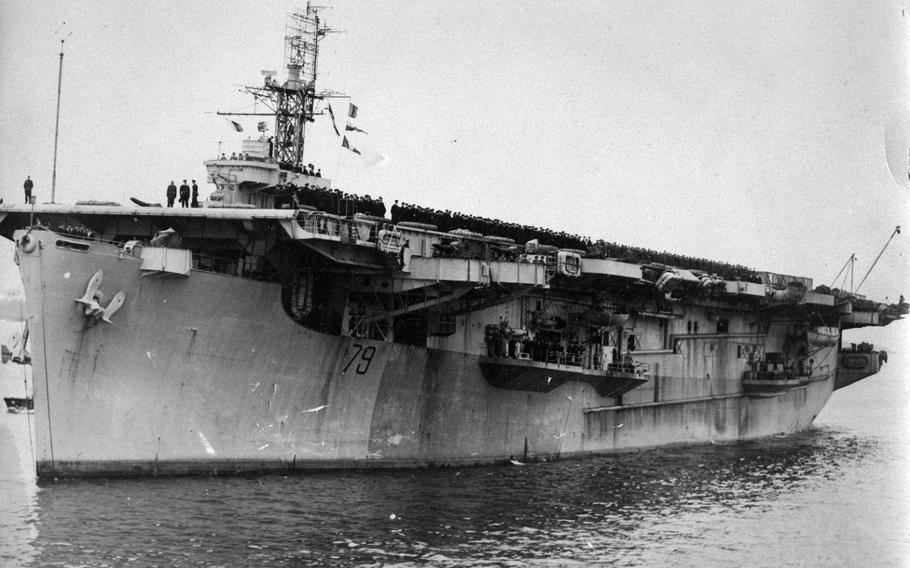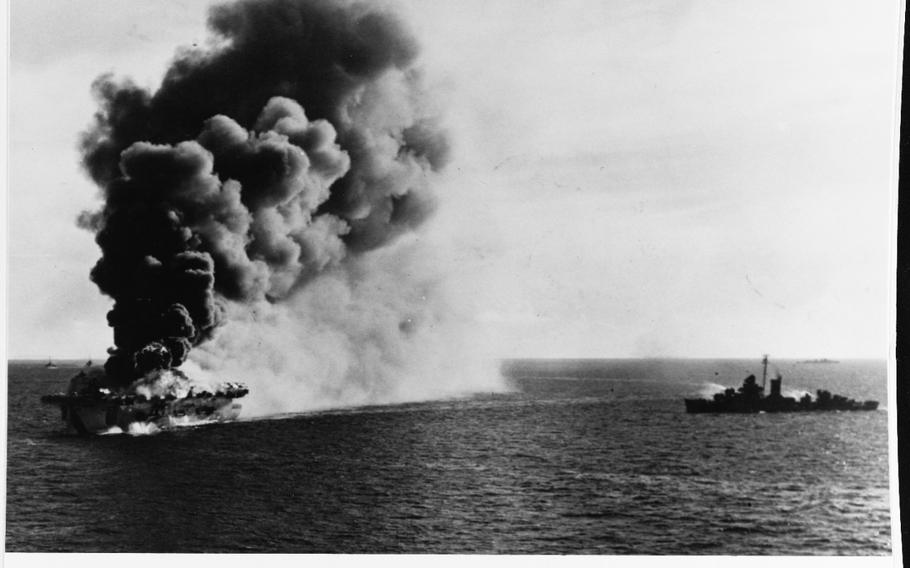
A undated photo of USS Ommaney Bay, which was sunk during WW II by a Japanese Kamikaze plane. A wreck of the U.S. aircraft carrier was identified in the Sulu Sea off the coast of the Philippines. (Naval History and Heritage Command)
A shipwreck discovered four years ago in the Sulu Sea off the coast of the Philippines has been identified as a U.S. aircraft carrier sunk by a Japanese Kamikaze plane in 1945, the Navy announced.
Service officials determined Monday that the shipwreck found in 2019 is the USS Ommaney Bay, according to the Naval History and Heritage Command. Some 95 American sailors were killed in the Jan. 5, 1945, attack on the Ommaney Bay, many of whom went down with the ship, according to the Navy.
“Ommaney Bay is the final resting place of American sailors who made the ultimate sacrifice in defense of their country,” retired Rear Adm. Samuel Cox, the director of the NHHC, said in a statement. “This discovery allows the families of those lost some amount of closure and gives us all another chance to remember and honor their service to our nation.”
The wreckage site’s location was provided in 2019 to the Navy by Vulcan, LLC, a company founded by the late Microsoft co-founder Paul Allen, which owns a shipwreck hunting vessel. The Navy said Tuesday that two Australian groups, Sea Scan Survey and DPT Scuba, helped confirm the Ommaney Bay’s identity with survey information and video footage captured in deep sea dives of the wreck site.
With Ommaney Bay’s shipwreck site, the Navy has located at least three American vessels this year sunk in the Pacific Theatre during World War II. The NHHC announced in February that it located the wreckage of the long-lost submarine USS Albacore and in May found the Navy destroyer USS Mannert L. Abele.
The more than 500-foot-long Ommaney Bay served less than six months in combat, and it was sunk weeks before the first anniversary of its commissioning. But Ommaney Bay, named for a body of water in Alaska, earned two Battle Stars for meritorious participation in battle during its short life, according to the Navy.

The USS Ommaney Bay exploding after being hit by a Kamikaze attack in the Sulu Sea off the coast of the Philippines in 1945. Two destroyers are standing by. (Naval History and Heritage Command)
In October 1944, the ship participated in the Battle off Samar in the Philippine Sea, launching airstrikes on Japanese positions. Ommaney Bay’s planes then helped sink a Japanese cruiser and damaged several other enemy warships.
In December 1944, Ommaney Bay was credited with downing a Japanese bomber aircraft near the Sulu Sea.
Just weeks later, as Ommaney Bay transited across the Sulu Sea bound for the Lingayen Gulf in the Philippines to support the U.S. invasion there, the ship was struck by a Kamikaze plane in the starboard side, the Navy said.
The aircraft released two bombs upon impact, according to the Navy. One hit the flight deck and detonated, setting off a series of explosions. The second passed through the hangar deck and exploded. The explosions led to a massive fire aboard the ship, which was carrying torpedoes and other ammunition.
A history of Ommaney Bay’s downing provided by the Navy describes .50 caliber ammunition ricocheting around the burning ship as commanders made the decision to abandon it, fearing the torpedoes would explode. Those munitions eventually detonated, killing two U.S. sailors on another ship that was assisting the Ommaney Bay after it was struck.
The Ommaney Bay’s wreckage site is now considered a protected location under U.S. law, the NHHC said.
“Most importantly, the wreck represents the final resting place of sailors who gave their life in defense of the nation and should be respected by all parties as a war grave,” according to the command.